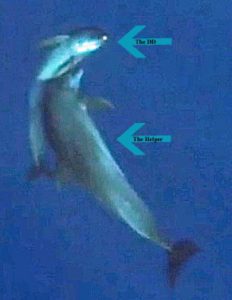There are many stories of dolphins saving people from various perilous situations including drowning and even shark attack. Until now, these events have been generally anecdotal and have been difficult to study systematically. However, the conspecific helping behaviour which may underlie these events is very interesting and has been scientifically documented on a few occassions.
So-called “epimeletic” (care-giving) behavior has been observed in a small number of mammalian species varying from mice to wolves; it has been most frequently observed in a number of cetacean species. These events have been documented in captivity and in the wild. Nonetheless, detailed observations are difficult, and little is known about what causes the animals to perform care giving behavior.
Recent work by Stan Kuczaj and colleagues published in the Psychonomic Society’s journal Learning and Behavior has documented an instance of epimeletic behavior in Atlantic bottlenose dolphins, a species whose presumed ability to help others in distress made it into popular culture a long time ago (e.g., Flipper).
During the short encounter the researchers filmed a female dolphin in distress and observed instances of helping behavior by other members of the pod. Further, for the first time, Kuczaj and colleagues were able to analyze the acoustic signals given by the distressed animal and to examine key questions which have, until now, been impossible to investigate: Are the helper animals responding to distress calls?
But what sort of care-giving responses might we expect to see in dolphins? The authors of the current study used definitions from the earlier literature which suggested that there are three different types of epimeletic behaviors in cetaceans. There is “Standing by”, in which animals remain close to an injured or distressed individual but do not provide active help. “Excitement” refers to behavior in which animals rapidly move around the distressed individual or are actively aggressive towards an apparent threat (remember the shark attack stories). The third type of epimeletic behavior is “support”, in which the animals push or lift the distressed individual, often towards the surface, potentially to allow it to breathe. Interestingly, group support behavior, in which several adults simultaneously provided support behavior has only recently been documented in the literature.
Dolphins produce individually distinct signature whistles which are thought to serve a number of functions. Whistles with similar acoustic patterns appear to function as contact calls, which are a means of maintaining group cohesion, but also distress calls. Distress calls (despite being acoustically very similar) appear to elicit a quite different response in other animals within the group. This response is likely to be modified by context. Kuczaj and colleagues suggest three fundamental contextual differences which permit differentiation between the two types of calls.
“1. A distress call elicits help from a healthy animal, whereas a contact call facilitates cohesion and may elicit a vocal reaction from or a reunion with another animal.
2. A distress call is repeated consistently until sufficient aid is received whereas a contact call is more likely to stop once the reunion is complete.
3. Other animals typically decrease their vocalization rates following a distress call, whereas contact calls that are facilitating group cohesion result in an increase in vocal responses”
So, what did Kuczaj and colleagues actually observe? The distressed dolphin (DD in the figure below) remained in a vertical position with no active movement throughout the encounter unless there was supportive behavior from the other dolphins. Interestingly, the supportive behaviors were exhibited by 4-5 helper dolphins at a time and were mostly pushes and lifts, which resulted in the distressed animal becoming active for short periods.

For example, she was able to swim alongside one of the other dolphins to break the surface and breathe. This sort of behavior fits with the “support” definition.
The distressed animal made repeated intense whistles and the intensity of the whistles correlated with the support behavior. The more whistles, the more support behavior was elicited. Interestingly, the distress whistles continued throughout the encounter whilst other dolphins’ calls were suppressed. This suppression is not what would be expected if the whistle served as a contact call, but it is consistent with the idea that a distress call will continue until enough aid is given. During the entire encounter the distressed dolphin emitted 282 whistles, corresponding to a call rate of around 15 times a minute, whilst all the other animals combined (in a group of around 20 dolphins) emitted only 31 whistles, corresponding to a call rate of 1.68 whistles per minute. At the end of the encounter the distressed dolphin sank from view.
The work by Kuczaj and colleagues is important as it documents the role of distress calls in epimeletic care in dolphins. It adds to key questions related to cooperation and the role of culture in dolphin society. This is not only important for understanding the extent of their cognitive abilities but has been recognized as a key factor for appropriate conservation. It appears that Flipper was not all fiction, after all.

2 Comments